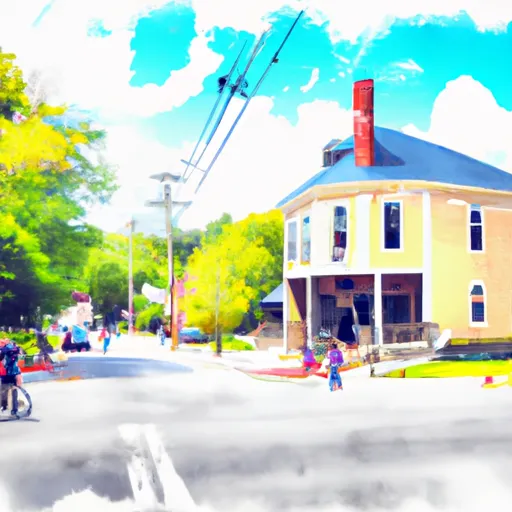-
 Snoflo Premium
Snoflo Premium
Get unlimited access to all our content
With no Ad interruptions! - Start Your Free Trial Login with existing account
Buckland
Eden Index
Climate
6.3
•
Recreation
3.5
•
Community
0.8
•
Safeguard
3.9/10

Buckland, Massachusetts is a small rural town located in the western part of the state. The climate in Buckland is characterized by warm summers and cold winters. The hydrology constituents of the town include a number of streams and small rivers, including the Buckland River, which flows through the center of town. Outdoor recreation opportunities in Buckland include hiking and biking in the nearby state forests, as well as fishing and kayaking on the local waterways. In addition, the town is surrounded by scenic vistas and offers a number of parks and open spaces for residents and visitors to enjoy. Overall, Buckland is a beautiful and peaceful place to live or visit, with plenty of natural beauty and opportunities for outdoor adventure.
What is the Eden Index?
The Snoflo Eden Index serves as a comprehensive rating system for regions, evaluating their desirability through a holistic assessment of climate health, outdoor recreation opportunities, and natural disaster risk, acknowledging the profound impact of these factors on livability and well-being.
Climate Health Indicator (CHI): 6.3
Buckland receives approximately
1305mm of rain per year,
with humidity levels near 82%
and air temperatures averaging around
8°C.
Buckland has a plant hardyness factor of
5, meaning
plants and agriculture in this region thrive during a short period during spring and early summer. Most
plants will die off during the colder winter months.
By considering the ideal temperature range, reliable water supplies, clean air, and stable seasonal rain or snowpacks, the Climate Health Indicator (CHI) underscores the significance of a healthy climate as the foundation for quality living.
A healthy climate is paramount for ensuring a high quality of life and livability in a region, fostering both physical well-being and environmental harmony. This can be characterized by ideal temperatures, reliable access to water supplies, clean air, and consistent seasonal rain or snowpacks.
Weather Forecast
Streamflow Conditions
Lower Connecticut
Area Rivers
Lower Connecticut
Snowpack Depths
Lower Connecticut
Reservoir Storage Capacity
Lower Connecticut
Groundwater Levels
Recreational Opportunity Index (ROI): 3.5
The Recreational Opportunity Index (ROI) recognizes the value of outdoor recreational options, such as parks, hiking trails, camping sites, and fishing spots, while acknowledging that climate plays a pivotal role in ensuring the comfort and consistency of these experiences.
Access to outdoor recreational opportunities, encompassing activities such as parks, hiking, camping, and fishing, is crucial for overall well-being, and the climate plays a pivotal role in enabling and enhancing these experiences, ensuring that individuals can engage in nature-based activities comfortably and consistently.
Camping Areas
| Campground | Campsites | Reservations | Toilets | Showers | Elevation |
|---|---|---|---|---|---|
| Haws Memorial - American Legion State Forest | 30 | 534 ft | |||
| Granville State Forest | 22 | 1,135 ft | |||
| Mohawk Trail State Forest | 56 | 762 ft | |||
| Grout Pond | None | 2,303 ft | |||
| Chester - Blanford State Forest | 12 | 516 ft | |||
| Townshend State Park | 35 | 586 ft | |||
| DAR State Forest | 50 | 1,456 ft | |||
| Windsor State Forest | 24 | 1,845 ft | |||
| Molly Stark State Park | 35 | 1,968 ft | |||
| Winhall Brook | 110 | 1,071 ft |
Nearby Ski Areas
Catastrophe Safeguard Index (CSI):
The Catastrophe Safeguard Index (CSI) recognizes that natural disaster risk, encompassing floods, fires, hurricanes, and tornadoes, can drastically affect safety and the overall appeal of an area.
The level of natural disaster risk in a region significantly affects safety and the overall livability, with climate change amplifying these risks by potentially increasing the frequency and intensity of events like floods, fires, hurricanes, and tornadoes, thereby posing substantial challenges to community resilience and well-being.
Community Resilience Indicator (CRI): 0.8
The Community Resilience Indicator (CRI) recognizes that education, healthcare, and socioeconomics are crucial to the well-being of a region. The CRI acknowledges the profound impact of these elements on residents' overall quality of life. By evaluating educational resources, healthcare accessibility, and economic inclusivity, the index captures the essential aspects that contribute to a thriving community, fostering resident satisfaction, equity, and social cohesion.

